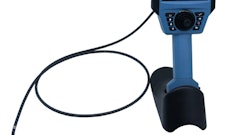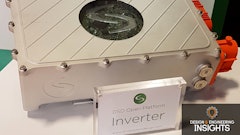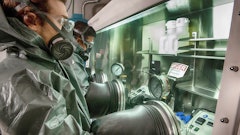Computer simulation reduced the time needed to develop a revolutionary engine lube centrifuge from approximately three years that would have been needed in the past to just one year. Centrifuges have been used as bypass filtration devices to remove contaminants from engine lube oil for several decades.
Fleetguard, which today is known as Cummins Filtration, used computational fluid dynamics (CFD) several years ago to identify inefficiencies in traditional designs and develop a new design that would provide cleaner oil and reduced engine wear. More recently, the company again used CFD to modify this design to improve manufacturability while maintaining the performance improvements of the earlier design.
Using the traditional approach of building machined or stereolithography prototypes and evaluating them on a test bench would have taken several years to go through the 40 or so configurations that were simulated prior to reaching the final design. CFD made it possible to evaluate the same number of designs in less than three months with minimal prototype fabrication. CFD also provides far more information and design insight than physical testing, which makes it possible to move much more quickly from the initial concept to the optimized design.
Increasingly stringent environmental requirements, coupled with increasing engine power density and customer expectations for long service intervals, are causing diesel engine lube oil to come under ever-increasing chemical, thermal, and particle mass loads. With improvements in oil formulations and full-flow filtration technology reaching maturity, engine manufacturers are increasingly looking towards bypass centrifuges to reduce their oil particulate loads and improve engine life.
A bypass centrifuge diverts a small percentage of oil pump output and cleans that oil to a higher level than the full-flow filter, before returning it directly back to the sump. These types of bypass systems are sometimes referred to as "kidney loops". Traditional centrifuges use a rotor that is typically driven in rotation at speeds from 4,000 to 10,000 rpm. Prior to studying new designs, Cummins Filtration engineers were interested in evaluating the performance of these early designs, which had been developed long before the advent of computer simulation.
Building virtual prototypes
CFD was selected as its primary analysis tool because of the extensive information and insight that can be obtained by studying the resulting complex flow phenomena, and because of the unique ability to quickly evaluate the effect of changing geometry or flow parameters on performance.
CFD can also facilitate detailed parametric studies that can significantly reduce the amount of experimentation necessary to develop a prototype for a new design, thereby reducing design cycle times and costs. Modeling centrifuge operation with CFD is challenging because the centrifugal acceleration at the perimeter of the rotor typically ranges from 2,000 to 6,000 g's, which causes radial pressure gradients that are many orders of magnitude higher than the axial gradients.
Fleetguard engineers selected Fluent CFD software from Fluent Inc., Lebanon, NH (acquired by ANSYS Inc. earlier this year), because it demonstrated the ability to consistently reach solutions on these challenging models. Furthermore, its discrete phase particle model enables direct assessment of centrifuge particle removal efficiency vs. particle size.
Cummins Filtration first analyzed the traditional engine lube centrifuge design, which consists of a cylindrical vessel with a central hub, rotating on a fixed shaft which also supplies oil to the vessel through a drilled port. Flow is introduced into the centrifuge through the shaft, from where it flows upward to the centrifuge inlet hole at the top of the hub.
After passing through the separation zone of the rotor, the flow passes an internal divider plate and exits through jet nozzles at the bottom. The centrifugal acceleration inside the rotor causes particles that are more dense than oil to collect on the inner surface of the cylindrical outer wall. Since there are no significant circumferential interruptions inside the rotor, engineers set up a simple 2D model that properly accounts for swirl velocities, but neglects any circumferential gradients.
The 2D geometry was imported from the AutoCAD computer aided design software into Fluent's Gambit preprocessor, where it was meshed with approximately 70,000 cells. The analysis showed that, when rotating at high speed during normal operation, the primary flow passing through the rotor collapses into a thin cylindrical sheath adjacent to the central hub. The proximity of flow to the center (where centrifugal force is lowest) coupled with high flow velocity (minimizing "dwell time") results in greatly reduced separation efficiency.
Improving particle removal efficiency
After examining the CFD flow solution, engineers considered several possible design improvements, such as reducing the particle sedimentation distance by subdividing the flow into multiple channels. It has been known for over 100 years that reducing this distance can increase the separation efficiency of gravity separators and motor-driven centrifuges. The design they selected involves placing a stack of cones inside the rotor.
With this design, the flow passes inward through the gaps between the cones. The particles "drift" off the flow streamlines towards the surface of the cones due to the rotational acceleration and when they enter the fluid boundary layer on cone surface they are ejected outward (since the radial inward velocity component of fluid goes to zero in boundary layer) and deposited on the inside wall of rotor where they are compressed into a dense sludge "cake". The key advantage of this design is that particles only need to migrate across a very small gap vs. a much larger dimension as in the traditional designs.
The high separation efficiencies predicted by the CFD analysis closely agreed with experimental results. The CFD models also provided important insights into the complex flow through the cone stack and in sludge collection zone. The company launched a patented aftermarket centrifuge product line based on this design that offers higher efficiency, extended service intervals, and lower maintenance cost.
Based on the success of this product, the company made the decision to develop a new design involving a fully disposable-rotor, in order to improve manufacturability. It determined that a similar effect to the stacked cone design could be achieved by converting each cone into a spiral vane. Since the surfaces of the vanes are parallel, the entire array can be molded as a unit, whereas the cones in the earlier design needed to be individually molded and then assembled into a stack. Fleetguard engineers took advantage of rotationally periodic boundaries in the sludge collection zone and jet zone to model only one spiral vane segment, which greatly reduced the size of the 3D models to a point where they could be run overnight on a modest 600 Mhz PC equipped with 1 Gb of RAM. The CFD models helped the engineers understand the complex flow that occurs in this new design, enabling them to more quickly iterate toward a design with optimal cost-performance trade-offs.
Vane count vs. particle separation performance
CFD modeling enabled Cummins Filtration to zero in on important design parameters and assess cost-performance tradeoffs such as vane count vs. particle separation performance. In less than 60 days, over 40 different virtual prototypes with varying vane count, vane curvature, vane length, outside diameter, inside diameter, rotation speed, rotation direction, fluid flow rate and fluid viscosity were modeled and "virtually tested" to compare particle separation performance.
The highest predicted performance was provided by the log-spiral vane, the shape that is directly analogous to the cone stack. The simulation also showed that the rotation direction was important, with the optimal direction being the one in which the vanes are swept back relative to the rotation. A CFD study predicted a rapid diminishing return beyond about 15 vanes, which was confirmed in later testing.
Cummins Filtration saved money and time while improving the particle separation efficiency substantially above that which would have been achieved using traditional design methods. The new spiral vane design has significantly improved manufacturability vs. the stacked cone approach, yet it provides comparable particle separation efficiency. In addition to providing enhanced customer value and product performance, the insights gained from using CFD in centrifuge design has led Cummins Filtration engineers to numerous innovative and patented technologies.
Peter Herman is principal engineer of Advanced Separations Technology, Cummins Filtration.
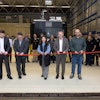
![Deutronic Dbl 1903 14[1]](https://img.oemoffhighway.com/files/base/acbm/ooh/image/2023/10/Deutronic___DBL_1903_14_1_.6528568875a4e.png?auto=format%2Ccompress&fit=crop&h=100&q=70&w=100)
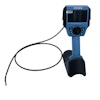

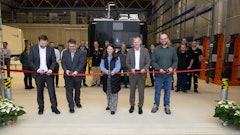
![Deutronic Dbl 1903 14[1]](https://img.oemoffhighway.com/files/base/acbm/ooh/image/2023/10/Deutronic___DBL_1903_14_1_.6528568875a4e.png?ar=16%3A9&auto=format%2Ccompress&fit=crop&h=135&q=70&w=240)
